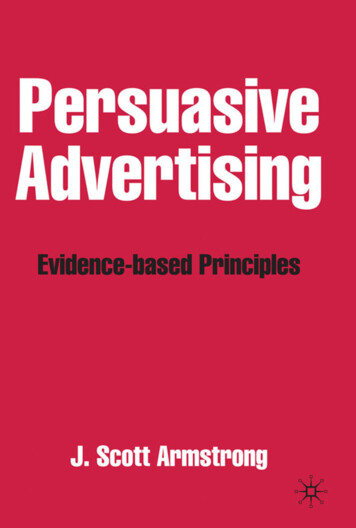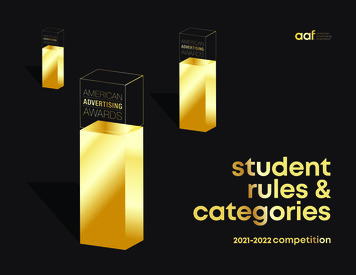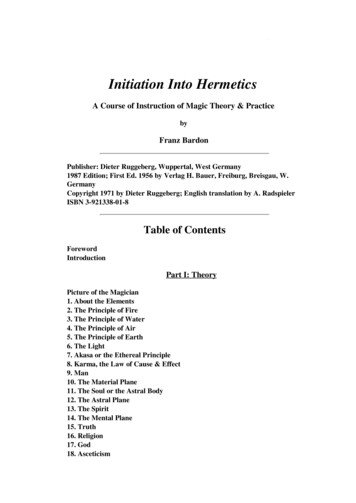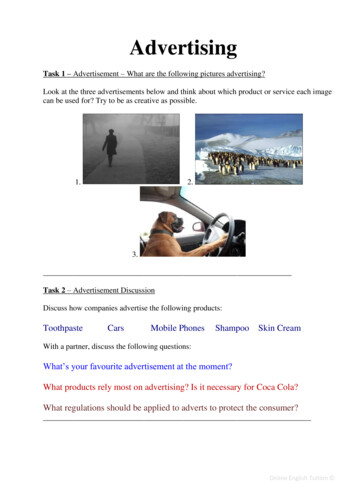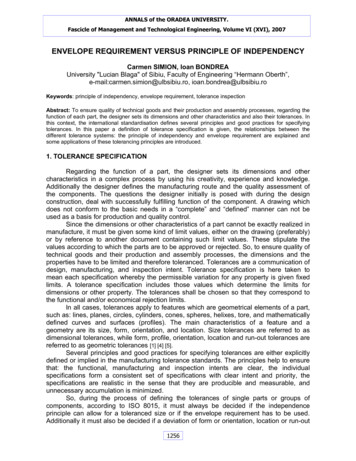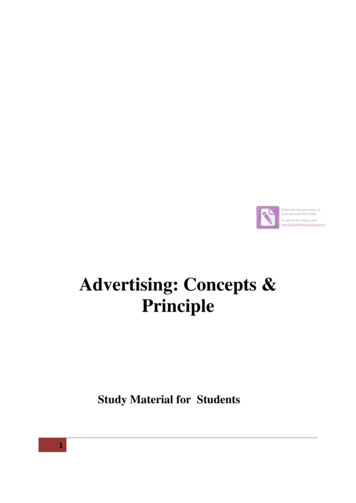
Transcription
BSCMCAJ-402: Advertising: Concepts & PrincipleEdited with the trial version ofFoxit Advanced PDF EditorTo remove this notice, visit:www.foxitsoftware.com/shoppingAdvertising: Concepts &PrincipleStudy Material for Students1
Edited with the trial version ofFoxit Advanced PDF EditorTo remove this notice, visit:www.foxitsoftware.com/shoppingBSCMCAJ-402: Advertising: Concepts & PrincipleCAREER OPPORTUNITIES IN MEDIA WORLDMass communication and Journalism is institutionalized and source specific.It functions through well-organized professionals and has an ever increasinginterlace. Mass media has a global availability and it has converted the wholeworld in to a global village. A qualified journalism professional can take up ajob of educating, entertaining, informing, persuading, interpreting, andguiding. Working in print media offers the opportunities to be a newsreporter, news presenter, an editor, a feature writer, a photojournalist, etc.Electronic media offers great opportunities of being a news reporter, newseditor, newsreader, programme host, interviewer, cameraman, producer,director, etc.Other titles of Mass Communication and Journalism professionals are scriptwriter, production assistant, technical director, floor manager, lightingdirector, scenic director, coordinator, creative director, advertiser, mediaplanner, media consultant, public relation officer, counselor, front officeexecutive, event manager and others.2
Edited with the trial version ofFoxit Advanced PDF EditorTo remove this notice, visit:www.foxitsoftware.com/shoppingBSCMCAJ-402: Advertising: Concepts & PrincipleINTRODUCTIONAdvertising is providing information, calling attention to, and making knownsomething that you want to sell or promote.The book introduces the students to advertising and covers the origin anddevelopment of advertising in India. Today advertising is a part of our everydaylife. It is all around us. Thus, the purpose and benefits of advertising are alsodiscussed in the book. The different types of advertising like the Commercial &Non – commercial, Product & Consumer, Classified & Display, Retail &Wholesale, Regional, National & Co-operative, Govt. advertising, Comparativeadvertising are also discussed in the book.Advertising acts as a communication, PR and Marketing tool which areelaborated in this book. The students will also learn the effects of advertising.3
Edited with the trial version ofFoxit Advanced PDF EditorTo remove this notice, visit:www.foxitsoftware.com/shoppingBSCMCAJ-402: Advertising: Concepts & PrincipleINDEX402 Advertising: Concepts & Principle1. INTRODUCTION TO ADVERTISING7- 151.1 Definition, Origin & development1.2 Growth of advertising in India1.3Advertising in the early 20th century1.4 Facets of advertising As an act of commerc e, as hidden persuader2. PURPOSE OF ADVERTISING16-252.1 Functions & Roles of advertising2.2 Scope Effects on Economy/Industry2.3 Benefits of advertising:2.3.1 Newspapers2.3.2. Magazines2.3.3. Yellow Pages2.3.4. Radio2.3.5. Television2.3.6. Direct Mail2.3.7. Telemarketing2.3.8. Specialty Advertising3. TYPES OF ADVERTISING3.1 Informational Advertising3.2 Non-commercial advertising3.3 Comparative advertising3.4 Regional Cooperative advertising3.5. Parts of Advertisements4. ADVERTISING AS A COMMUNICATION TOOL4.1 Communication Process & Advertising4.2 Communication4.3 Theories applied to advertising5. ADVERTISING AS A MARKETING TOOL5.1 Concept of Marketing & advertising5.2 Marketing Mix - 5 P's in marketing5.3. Advertisements And Its Effects5.4 The harm done by advertising425-3435-4546-55
Edited with the trial version ofFoxit Advanced PDF EditorTo remove this notice, visit:www.foxitsoftware.com/shoppingBSCMCAJ-402: Advertising: Concepts & Principle6. ADVERTISING AS A PR TOOL6.1. What is Public Relations?6.2 Advantages of PR6.3 Disadvantages of PR6.4. How Advertising Differs From Public Relations7. ADVERTISING THEORIES 61-827.1. Ethical Advertising Standard7.2. Code of the Advertising Standards COUNCIL OF INDIA7.3. Brand personality7.3 Role, function & types of Advertising agency8. ROLE & EFFECTS OF ADVERTISING 83-1008.1 Negative & Positive Effects8.2. Publicity, Propagandas, Sales Promotion8.3. Design, Production and The Role Of External Agencies8.4 Effects of Advertising On Society8.5. Tips to Produce The Best Advertisement Layout8.6. How to Create An Advertisement?Summery 100Questions for Practice 102Suggested Reading 102556-60
Edited with the trial version ofFoxit Advanced PDF EditorTo remove this notice, visit:www.foxitsoftware.com/shoppingBSCMCAJ-402: Advertising: Concepts & PrincipleSYLLABUSAdvertising: Concepts & Principle1. INTRODUCTION TO ADVERTISINGDefinition, Origin & development, Growth of advertising in India, Scope Effectson Economy/Industry, Facets of advertising As an act of commerce, as hiddenpersuader)2. PURPOSE OF ADVERTISINGNeed for advertising, Functions of advertising, Benefits of advertising: To Seller,Buyer & Media3. TYPES OF ADVERTISINGCommercial & Non – commercial, Product & Consumer, Classified & Display,Retail & Wholesale, Regional, National & Co-operative, Govt. advertising,Comparative advertising4. ADVERTISING AS A COMMUNICATION TOOLCommunication Process & Advertising, Communication Principles, Theoriesapplied to advertising5. ADVERTISING AS A MARKETING TOOLConcept of Marketing & advertising, Marketing Mix - 5 P's in marketing,Segmentation of consumer & positioning of product6. ADVERTISING AS A PR TOOLRelationship of Advertising & Public Relation, Corporate/Institutional Advertising7. ADVERTISING THEORIESUnique Selling Proposition, Brand Image, Relevance to Indian Advertising8. ROLE & EFFECTS OF ADVERTISINGNegative & Positive Effects, Advertising & Society, Advertising & Development,Role of advertising in National Economy, Social/Public Advertising.6
Edited with the trial version ofFoxit Advanced PDF EditorTo remove this notice, visit:www.foxitsoftware.com/shoppingBSCMCAJ-402: Advertising: Concepts & PrincipleADVERTISING: CONCEPTS & PRINCIPLEOBJECTIVES to know the origin & development,to trace the growth of advertising in Indiato understand the purpose of advertisingto learn the different types of advertisingto see advertising as a communication toolto see advertising as a marketing toolto see advertising as a pr toolto understand advertising theoriesto know the role & effects of advertisingINTRODUCTION TO ADVERTISING1.1. DEFINITIONFor the common men advertising means television commercials, radio jingles andprint advertisements. Advertising can be defined as a paid dissemination ofinformation through a variety of mass communication media to motivate adesired action. According the ‘concise oxford dictionary’ the verb, ‘to advertise’means: to make generally or publicly known.Jeremy Bullmore defines advertising as ‘Advertising is any paid –forcommunication intended to inform and /or influence one or more people’.Here, the first element paid for distinguishes advertising from free publicity. Thesecond element communication indicates transmission of messages and the use of amedium. The third element intentional is about advertisements being goal-oriented.Fourthly, inform and/or influence indicates about the persuasive nature ofadvertising.One of the earliest definitions of advertising was: ‘The dissemination ofinformation concerning an idea, service or product to compel action inaccordance with the interest of the advertiser’.7
Edited with the trial version ofFoxit Advanced PDF EditorTo remove this notice, visit:www.foxitsoftware.com/shoppingBSCMCAJ-402: Advertising: Concepts & PrincipleThis definition tells us about advertising being a kind of communication about aproduct, service or idea, and is being goal-oriented. However, it does not includemany important aspects of advertising.Thus, Advertising can be best defined as: ‘any paid for non-personalcommunication used with persuasive intent by identified sponsors thoughvarious media to promote goods, services and ideas, etc.’Today advertising is a part of our everyday life. It is all around us. We cannotescape looking at it or listening to it. Even if we are not consciously looking at it orlistening to it, the message of advertising reaches and influences us. It is oftenrecorded somewhere at the back of our minds and is recalled when we are buyingsomething or looking for a particular service.From morning to night, we are using advertised goods and services. We start themorning with a cup of tea or coffee, use toothpaste and toothbrush on our teeth, atbreakfast we have bread, butter, etc. our workplace is also full of machines,computers, etc which are the advertised goods.Prof. James E. Littlefield and Prof. C.A. Kirkpatrick in their book defineadvertising as follows: ‘Advertising is mass communication of informationintended to persuade buyers so as to maximize the profit’.This definition is again not complete.American Marketing Association AMA defines advertising as: ‘Advertising isany form of non-personal presentation of goods, services or ideas for action,openly paid for by an identified sponsor’.The key elements in the above definition are:Any formAdvertising can take any of the following forms of presentation. It could be a sign,symbol, illustration, verbal message, etc. advertising can be in any form that bestconveys the message.Non-personalThis phrase distinguishes advertising from personal selling; as advertising is anindirect form of conveying messages.8
Edited with the trial version ofFoxit Advanced PDF EditorTo remove this notice, visit:www.foxitsoftware.com/shoppingBSCMCAJ-402: Advertising: Concepts & PrincipleGoods, services or ideasAdvertising promotes goods, services and ideas. It also promotes persons andparties, places and events as well as institutions.For ActionThis phrase denotes the action-oriented nature of advertising.Paid forAdvertising is always paid for. It is not free. So it is distinguished from freepublicity.By an Identified SponsorPeople or groups who do not identify themselves do a lot of publicity andpropaganda. In such cases a kind of manipulative or malicious intent is associated.However, in case of advertising no such intent is present as the sponsor is alwaysidentified. We always know who the advertiser is.1.1.1. Origin & Development of AdvertisingThe origin of advertising as a public announcement is traceable to the town crierand the village drummer. They used their lungs to shout out their own or others’messages. The messages could relate to government proclamation or even to salesof goods on ‘market days’. Then there were signs on shops or drinking houses toindicate the name of the shop owner or of the shop. The highly urbanized cities ofMohenjodaro and Harappa in India must have employed some form of advertisingto sell the many types of art and craft items that the ancient civilizations werefamous for.Advertising as a discrete form is generally agreed to have begun with newspapers,in the seventeenth century, which included line or classified advertising. Simpledescriptions, plus prices, of products served their purpose until the late nineteenthcentury, when technological advances meant that illustrations could be added toadvertising, and color was also an option.Excavation in Pompeii and other ancient cities have also thrown up evidence ofsome form of advertising. Says one advertisement in Latin found in Pompeii: ‘Acopper pot has been taken from this shop. Whoever brings it back will receive 65cents. If anyone shall hand over the thief, he will receive an additional reward’.Such a public announcement has a striking resemblance to modern ‘classified’9
Edited with the trial version ofFoxit Advanced PDF EditorTo remove this notice, visit:www.foxitsoftware.com/shoppingBSCMCAJ-402: Advertising: Concepts & Principleadvertisements. Further, an excavation suggests that notices of theaterperformances, games, entertainments, and other public events were painted on thewalls of the busy centers of the city. This was also the practice among the ancientRomans: they used ‘albums’ places on walls made smooth and white for writingor carving, stone tablets and even playing cards for making announcements ofpublic interest. Public notices were places in the ‘Acta Diurna’, a wall-newspaperthat provided daily news of Senate politics.DevelopmentsModern advertising was made possible by the invention of printing, and thesubsequent attempts to print notices, posters and bills in large numbers. However,it was the industrial revolution in Europe, combined with large-scale urbanizationand mass production of goods, and the growth of the publishing business that madethe expansion of competitive advertising possible. The eighteenth and nineteenthcenturies in Europe and the United States were witness to massive migration ofpeople from rural to urban areas, there to work in factories and live in crowdedunhygienic conditions. The industrial revolution proved to be a success on the backof the working –classes, and the availability of large markets in the ‘colonies’ fromwhere cheap raw material could be bought.Mass production resulted in the need to market the products as they rolled out offactories. Advertising was hit upon as a powerful tool to stimulate public demandfor standardized factory products. Advertising was welcomed by the growingprinting and publishing trades as it subsidized their costs of production, this went along way in keeping the price of newspapers low. By 1861 there were as many as5,000 newspapers and magazines in the United States, with several of thempublishing more advertisements than news or articles. ‘Space sellers’ entered thebusiness world to act as middlemen or brokers between the manufacturers and thepress.Advertising is providing information, calling attention to, and making knownsomething that you want to sell or promote.Advertising is a message designed to promote or sell a product, a service, or anidea. Advertising reaches people through varied types of mass communication. Ineveryday life, people come into contact with many different kinds of advertising.Printed ads are found in newspapers and magazines. Poster ads are placed in buses,subways, and trains. Neon signs are scattered along downtown streets. Billboards10
Edited with the trial version ofFoxit Advanced PDF EditorTo remove this notice, visit:www.foxitsoftware.com/shoppingBSCMCAJ-402: Advertising: Concepts & Principledot the landscape along our highways. Commercials interrupt radio and televisionprogramming.Advertising is a multibillion-dollar industry. In many businesses, sales volumedepends on the amount of advertising done. Manufacturers try to persuade peopleto buy their products. Business firms use advertising to promote an "image" fortheir company. Businesses use advertising to gain new customers and increasesales.Individuals, political candidates and their parties, organizations and groups, and thegovernment also advertise. The armed forces use ads to recruit volunteers. Specialinterest groups promote a cause or try to influence people's thoughts and actions.Politicians use ads to try to win votes. And people advertise in newspapers to sellcars, homes, property, or other items. Prior to considering methods of advertisingand marketing it is important to ensure that you understand and adhere to localcountry laws relating to data protection and customer rights concerning privacyand opt-out of various marketing methods. This especially relates to maintainingand using lists and people's personal details, to the use of telemarketing, directmail, fax marketing, and email. Generally private consumers enjoy more protectionthan business-to-business customers.1.2. Growth of Advertising in IndiaIndian Advertising starts with the hawkers calling out their wares right from thedays when cities and markets first began. Concrete advertising history beginswith classified advertising. Ads appear for the first time in print in Hickey'sBengal Gazette, India's first newspaper weekly. To ‘advertise’ meant merelyto ‘inform’ until the end of the eighteenth century, and the early newspapers andperiodicals announced births, deaths, arrivals of ships from England, sale ofhousehold furniture, etc. some journals like the Bengal Journal first published in1785 even offered to print government advertisements free.The front page of most such journals carried only advertisements, but before longpersuasive copy began to replace mere information. This is evident from theappearance of punch lines such as ‘superior to anything of the kind hithertoimported’ and ‘warranted to the first quality’. Discounts and special services alsobegan to be offered by the beginning of the nineteenth century. Later, newproducts and services established themselves on the market through theadvertisement columns of the newspapers and periodicals. The power ofadvertising increased rapidly with the growth in trade and commerce.11
Edited with the trial version ofFoxit Advanced PDF EditorTo remove this notice, visit:www.foxitsoftware.com/shoppingBSCMCAJ-402: Advertising: Concepts & PrincipleWith the increasing impact of the industrial revolution on our country, the numberof advertisements from British business houses rose sharply. ‘Agents’ flourished atthe time as space contractors, obtaining advertisements for newspapers andperiodicals on a commission basis. Leading newspapers like ‘The Statement’ and‘The Times of India’, which had their own advertising departments, offered theirown facilities to ‘agents’. This was of great advantage to both the advertiser andthe publisher, for the advertiser, it saved the bother of preparing a suitable layoutfor the advertisements, for the publisher, it assured a certain uniformity of standardin the advertisements appearing in its column. This practice was responsible forturning advertising into a distinct profession. These ‘agents’ were forerunners ofthe ‘advertising agencies’.1.3 Advertising in the early 20th centuryTwo main events responsible for growth of Indian advertising agencies were: theSwadeshi Movement 1907 -1911, which gave rise to indigenous industries, andthe second, was the installation of first rotary linotype machine by the Statesmanof Calcutta in 1907.In few years, other papers too installed the new machine, which made it possible toproduce a cheap newspaper with a large national circulation. The first Indian AdAgency, the Indian Advertising Agency, was launched around this time, and is stillgoing strong. The main functions of these agencies were to secure advertisementsand to get them published in the press. The major British agencies during this timewere: Alliance Advertising Associates, Publicity Society of India, L.A. Stronachand Co, and others. They catered to the need of the affluent British and Indianelites living in the metropolitan cities. They rarely advertised Mass consumer itemslike tea and cigarettes.During the war, press advertising was exploited to raise funds for the war effort.Ad Agencies established during this period-included Alliance AdvertisingAssociation Ltd, at Bombay, started by the British India Cooperation of Kanpur, tosell its manufactured goods. Mr. L.A. Stronach, the manager of Alliance, boughtup the Bombay branch of the agency and started in 1922 his own agency, with abranch in London. It provided production and media services to advertisers unlikethe space-selling agencies and so even manufacturers of competing products orbrands had to use these services.12
Edited with the trial version ofFoxit Advanced PDF EditorTo remove this notice, visit:www.foxitsoftware.com/shoppingBSCMCAJ-402: Advertising: Concepts & PrincipleThe Inter-War YearsDuring the inter-war years a few Indian agencies too sprang up, the most notablebeing the modern Publicity Co. in Madras, the Calcutta Publicity, and the OrientalAdvertising Agency in Tiruchirapalli. The Vasudevea Publicity Service was startedin Delhi to carry out outdoor publicity campaigns in Uttar Pradesh, Punjab andDelhi. In 1931, the first full-fledged Indian Ad Agency, the National AdvertisingService, was established. Among the other Indian Agencies to be launched duringthis period were: New India Publicity Co. 1930, Paradise Advertising Agency ofCalcutta 1928, the Indian and Eastern Newspapers Society IENS), and others.The IENS was set up as a central organization of the newspaper owners of India,Burma and Ceylon. The society looked after the interests of newspaper publishinghouses; an indirect effect of the formation of the IENS was the standardization ofAd agency practices. The IENS also sought to foster better publisher agencyrelationship.The establishment of the Advertising Agencies Association of India AAAI in1945 and the Audit Bureau of Circulation ABC in 1948 helped to bring someorder to the competitive field. The AAAI came to be recognized as a representativebody of the profession, with the authority to represent its interests and problems.The ABC gave some credibility to the claims of newspapers regarding theircirculation.Post-Independence AdvertisingFollowing World War II and the Indian Independence, the British-owned agencieswere sold to Indian business. Several agencies, however, retained an ‘affiliate’status with the main branches of the agencies in London. They continue to enjoythis status even today, though American multinational agencies have replacedaffiliation with British agencies.At independence the advertising business was well on its way to growth andexpansion. Partition did not touch the business at all. The introduction of multicolor printing, improved printing machines like offset and web offset, and thedevelopment of commercial art gave the Ad business a further leap. Agenciesbegan to offer, besides space selling, many more services, such as artwork,organization of fairs and exhibitions, market research, public relationsconsultancies.13
Edited with the trial version ofFoxit Advanced PDF EditorTo remove this notice, visit:www.foxitsoftware.com/shoppingBSCMCAJ-402: Advertising: Concepts & PrincipleThe phenomenal growth in the media, especially television and cable has given aboost to Indian advertising. Market research and readership surveys have led to thefurther professionalization of the business. Individual publishing houses like ‘TheHindu and The Times of India’ first conducted readership surveys. Now, NationalReadership Surveys NRS) and Indian Readership Surveys IRS) as well asregular Television Rating Points TRP measurements provide advertisers withstatistical data on which to base their media plans.1.4. Facets of AdvertisingThese are just a few of highly effective techniques of persuasion. Other methodsinclude the use of rewards, punishments, positive or negative expertise, moralappeal, and many others.Create a NeedOne method of persuasion involves creating a need or an appealing a previouslyexiting need. This type of persuasion appeals to a person’s fundamental needs forshelter, love, self-esteem, and self-actualization.14
Edited with the trial version ofFoxit Advanced PDF EditorTo remove this notice, visit:www.foxitsoftware.com/shoppingBSCMCAJ-402: Advertising: Concepts & PrincipleAppeal to Social NeedsAnother very effective persuasive method appeals to the need to be popular,prestigious, or similar to others. Television commercials provide many example ofthis type of persuasion, where viewers are encouraged to purchase items so theycan be like everyone else or be like a well-known or well-respected person.Television advertisements are a huge source of exposure to persuasion consideringthat some estimates claim that the average American watches between 1,500 to2,000 hours of television every year.Use Loaded Words and ImagesPersuasion also often makes use of loaded words and images. Advertisers are wellaware of the power of positive words, which is why so many advertisers utilizephrases such as “New and Improved” or “All Natural.The examples above are just a few of the many persuasion techniques described bysocial psychologists. Look for examples of persuasion in your daily experience. Aninteresting experiment is to view a half-hour of a random television program andnote every instance of persuasive advertising. The amount of persuasive techniquesused in such a brief period of time can be astonishing.15
Edited with the trial version ofFoxit Advanced PDF EditorTo remove this notice, visit:www.foxitsoftware.com/shoppingBSCMCAJ-402: Advertising: Concepts & PrincipleUNIT 2. PURPOSE AND GOALS OF ADVERTISINGAdvertising is just not for information, but for a purpose. This purpose is tomotivate a desired action. People use advertising to achieve a variety of objectives.The broad functions are to inform, educate, and persuade. The subsidiaryfunctions are to create awareness, change attitudes and generally to gainacceptability. In case of product and service advertising, the objective is to informthe consumers and generate demand. Institutional and ideas advertising aredesigned to create a favorable attitude and acceptability.2.1. Thus, the functions/roles/purposes of advertising are many:1. Marketing- Marketing is the strategic process in business that is used tosatisfy consumer needs and wants through goods and services, to reach itstarget audiences, marketing use many tools of promotion. Also known asmarketing communication, these tools include personal selling, salespromotion, public relations and of course, advertising. Advertising is themost widely used and most visible of promotional tools in marketing.2. Communication- Advertising is a commercial form of masscommunication. It transmits different types of marketing information andtries to match buyers and sellers in the market place. Advertising not onlyinforms prospective buyers, it also transforms the product by creating apersonality for it. Using visuals, words, music, drama and lot of other things,advertising creates an image for the product that goes beyond mere facts.3. Economic role- Advertising play an important role in the economy byhelping the society to achieve abundance by informing and persuadingpeople about products, services and goods. Advertising assists in thedevelopment of judgment on the part of consumers in their purchasepractices. Simply put, advertising helps consumers make informed buyersdecisions. Others believe that advertising is a source of information thatincreases the price sensitivity and stimulates competition.4. Social role- Advertising plays a number of social roles. It informs us aboutnew and improved products. Sometimes it tells us how to use certainproducts. It also helps us compare products and services.16
Edited with the trial version ofFoxit Advanced PDF EditorTo remove this notice, visit:www.foxitsoftware.com/shoppingBSCMCAJ-402: Advertising: Concepts & Principle5. Improve sales- Advertising can also be for winning back the lostconsumers, by announcing some improvements, new schemes, attractivepackages, or better quality of the product or services. It might be necessaryto reduce prices to hold on the consumers against competition.6. Provide satisfaction- A consumer buys a product or service for thesatisfaction it provides. The interest is not in the product or service for itself,but in the satisfaction it provides. It can be psychological too. If one buys asoap which is advertised as the beauty soap of the stars, one knows very wellthat one cannot become a film star by using the soap or even acquire thecomplexion of the film star. The psychological satisfaction is of the selfdelusion that one uses the same toilet soap as a film star.7. Sells Lifestyle- Advertising also sells lifestyle. This is very true of theadvertisements of such products as pressure cookers or gas stoves. Thesemight be described as conveniences products. Thus, advertising createsdemands for the new products and hence creates a lifestyle.8. Provide Employment- Without advertising, products and services could notbe sold in sufficient quantities. Without sales, factories would close downcausing unemployment. Thus advertising stimulates economy by providingemployments to many people.9. Revenue for Media-It is true that newspapers, periodicals and even theelectronic media depend on advertising as a major source of revenue.10.Influences Public Opinion-Advertising today has become a very powerfulinstrument for motivating public opinion and action. That is why it is usedfor political campaigns as well.2.2. Scope Effects on Economy/IndustryBusinesses that continue to advertise regardless of economic times have acompetitive advantage over businesses that trim their ad budgets.So says a business-to-business b -to-b media study. The study showed more than85 percent of business executives believe advertising during a down economy isextremely important.17
Edited with the trial version ofFoxit Advanced PDF EditorTo remove this notice, visit:www.foxitsoftware.com/shoppingBSCMCAJ-402: Advertising: Concepts & PrincipleB-to-B media is an undisputed ally for advertisers seeking to reach executivesabout products and services for their businesses. The study, prepared for AmericanBusiness Media, showed that despite slow economic times, executives rely on b-tob media for information more than any other media source for the influence orsupport of purchase decisions.Competitive advantageAdvertising during a sluggish economy clearly creates a competitive advantage,with a majority of executives agreeing that seeing a company advertise duringslower times makes them feel more positive about the company’s commitment toits products and services. But perhaps most important is staying at the top ofbuyers’ minds when purchase decisions are made.“For advertisers interested in maximum profit from their investment in b-to-bmedia, these research results indicate that advertising frequently and capitalizingon the synergistic effect of print, Web sites and trade shows is a sure path toincreasing awareness, interest and purc
5. ADVERTISING AS A MARKETING TOOL 46-55 5.1 Concept of Marketing & advertising 5.2 Marketing Mix -5 P's in marketing 5.3. Advertisements And Its Effects 5.4 The harm done by ad

